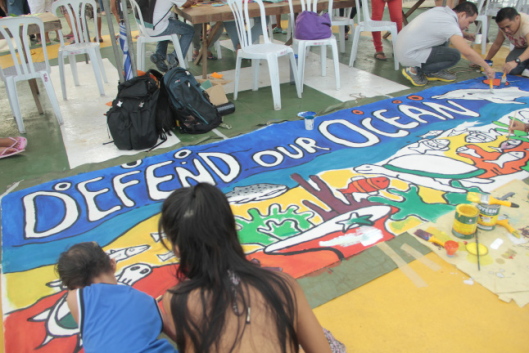By Maya Angelique B. Jajalla
When light passes through water, a rainbow is formed.
In the story of the great flood in the book of Exodus, a rainbow appeared after Noah’s Ark sailed through the deluge. The arc in the sky with seven colors symbolized God’s covenant between man and Him. The rainbow held a new promise: the promise of hope.
Today, hope comes in many forms. It can be a fleeting feeling. It can be a fleet itself, sailing between light and water. Today, hope can even be heard. It can be said in many dialects. It can be spoken in different ways.
“Hope”, in the Spanish language, literally means “esperanza”.
M/Y Esperanza: MY HOPE
Last Friday, M/Y Esperanza docked in the port of Dumaguete City for the Ocean Defender Tour of Southeast Asia 2013. Esperanza is Greenpeace’s largest ocean vessel in a fleet of three: The Rainbow Warrior, Arctic Sunrise and Esperanza. Greenpeace is an independent global organization which campaigns for environmental sustainability. Its ships are used to manoeuvre the organization’s advocacies, sailing to “remote areas to bear witness and take action against environmental destruction.”
“We go to where we are needed,” said Vince Cinches, Oceans Campaigner. Where the problem is, there the ships will also be.
The City of Gentle People is Esperanza’s one of only four stops in the country. It paid a visit to Apo Island last week and is set to visit Bicol and Manila. It leaves the country on Friday.
But why visit Dumaguete among the many places in the Philippines?
“It’s really because of Apo Island and Silliman’s role in preserving it,” Mark Dia, Regional Oceans Campaigner, said.
Apo Island, dubbed as one of the world’s premier diving spots, is also home to the country’s top community-managed marine reserve. It is also an emerging tourist destination in the archipelago.
So, where’s the problem in that?
Grief over damaged reefs
Due to heavy battering waves brought by typhoons Sendong and Pablo, and the 6.9 magnitude earthquake that hit Negros Oriental last February 6, 2012,“extensive reef damage” was reported in the surrounding area of Apo Island.
Dr. Angel Alcala, director of the Silliman University (SU) Angelo King Center for Research and Environmental Management, reported last Friday that from an average of 150 tons of bio-mass fish a year, fish yield outside the no-take zone has now dropped to as low as 15 tons a year.
According to the National Statistical Coordination Board, the Philippines ranked 11th in the world in terms of fish production, yielding a total of 2.27 million metric tons in 1990. The country also placed third in tuna production and was the top producer of cultivated seaweed (carrageenan) in the world on that same year. However, we no longer hold the position since the year 1990.
The Coastal Conservation and Education Foundation and the SU Institute of Environmental and Marine Sciences have been doing regular reef checks in the island. Last week, Greenpeace volunteers joined in the counting of marine species and installation of coral modules.
Cinches added that they will report the data that Greenpeace has gathered in its reef check to the Philippine government. “We want to discuss this problem with them so that we can create solutions… because we believe that the corals can be saved and [the national government] can help us with that.”
How can the Negrense contribute to the fast recovery of the Apo reefs? “We can do nothing but allow the sea to heal itself,” Dia answered.
However, there is a higher problem that affects the whole world: climate change. Greenpeace claims that together with fossil fuel usage in the ocean, climate change is the ocean’s silent killer.
If we continue to exploit our once abundant seas and marine lives, our grandchildren will never know the taste of sinigang na hipon.
Attack of the ‘sea monsters’
On July 13, Esperanza opened its deck for the public, spreading awareness on marine life issues while Greenpeace volunteers toured visitors around the vessel.
There were inflatable boats inside Esperanza which are used when volunteers rescue a whale, clean a certain part of the sea or operate on a certain project. The guide also showed where the control room is. While a crew member explained which button does what, a kid of about eight years old raised his hand and asked: “How do you track sea monsters?”
The adults in the room laughed at the innocent question. The crew played along, taking the binoculars and told the kid that he can look out for sea monsters through the lens.
Sea monsters with large fangs and thorny fins may just be a myth. But the real sea monsters are not even in the ocean. They’re the ones who are on land, throwing their pieces of garbage to the sea.
So how do we track sea monsters? We start by looking at ourselves.
The revenge of the sea
The ocean covers 71% of the world. From afar, the Earth is the “blue planet”. Water makes us stand out from the rest of the planet in a universe run by the sun.
Sadly, reef damages are not only happening in Apo Island. They happen everywhere. Because of the continuous drop of catch fishermen are experiencing right now, the issue on territorial disputes and fishing zones arise. While we try to cope with a loss, two more potential losses await us. When fear of scarcity and hunger strike, war brews between nations.
It may take two decades for the reefs in Apo Island to recover, Greenpeace said. It may take longer if we “disturb” it. The earth is getting older and it’s not aging gracefully because of man’s negligence.
Passenger’s song “Let Her Go” says: ‘Cause you only need the light when it’s burning low. Only miss the sun when it starts to snow. Only know you love her when you let her go.
Will we only love “her” when we let her go?



